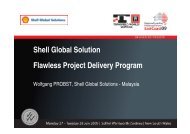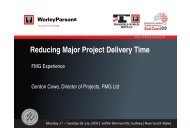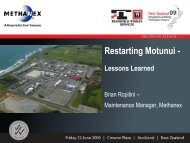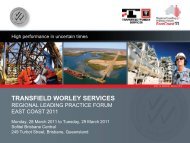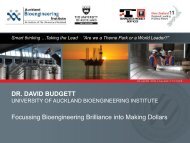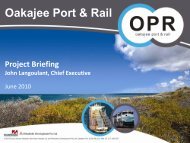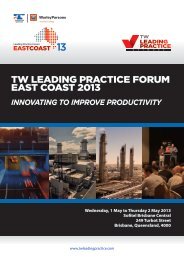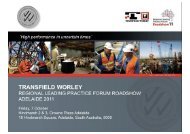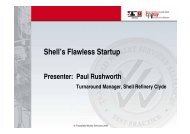LOOK AT US NOW - Transfield Worley
LOOK AT US NOW - Transfield Worley
LOOK AT US NOW - Transfield Worley
You also want an ePaper? Increase the reach of your titles
YUMPU automatically turns print PDFs into web optimized ePapers that Google loves.
transfieldservices.comTHE TRANSFIELD SERVICES B<strong>US</strong>INESS MAGAZINE17FE<strong>AT</strong>UREWORKINGTOGETHERRethinking the master/servant approachMost strategies and programs addressing our industry’s labour shortages are focusedon increasing the nation’s resource pool and enhancing skills. While these initiativesare critical, strategies aiming to maximise productivity with the resources currentlyavailable are also necessary.To understand what strategies will work, it is worth considering the role that outsourcing plays inthe industry and its working dynamic with operators.The increasing complexity of operating environments, in conjunction with the emergence andrapid growth of the outsourcing services industry over the last 15 years, mean that operatorsrarely work in isolation. These days it is common practice for key activities such as operations andmaintenance to be carried out by a third party service provider.Constructive relationships between operators and service providers are therefore critical tothe industry, and improving these relationships offers potential to improve overall productivitywithout the need for additional people.One strategy, which is being used to drive improvement is an approach known as an IntegratedServices Model (ISM). The model defines a performance based working relationship betweenoperator and service provider to facilitate a more complementary partnering approach that leadsto better planning and scheduling.<strong>Transfield</strong> ServicesManaging Director andCEO, PETER GOODE, isspeaking at the APPEAOil and Gas Conference inSouth Australia this month.Following is an extendedabstract of his presentationon overcoming theresource crisis using anintegrated services modelfor outsourcing.THE EVOLUTION OF OUTSOURCINGSince 1995, there has been a revolution in the use of outsourced services in the world’s resourcesand energy sector. Not only has there been an exponential growth in the use of outsourcing, butthe reasons why operators utilise this form of resourcing has changed significantly. Traditionalreasons include:STR<strong>AT</strong>EGIC – allows management to focus on core business.FLEXIBILITY OF LABOUR – either displacement or supplementary resources.SOCIAL/CULTURAL CHANGE – often focused on industrial relations.COST SHIFT – reduction of fixed costs, e.g. labour costs.SPECIALIST SERVICES – access to services which are unique or rarely used.EQUIPMENT – access to larger and better utilised equipment pool.In a typical contract, the operator micro managed (and in many cases still does) the service provider,wasting management resources on command and control rather than on the pursuit of strategic,value adding activities. At the same time, service providers were structured into being passiveprice takers. They did only what was asked for in the contract and had no incentive to improveproductivity or efficiency, in fact it was often a disincentive.The adversarial nature of a price-only relationship moderator also drove service providers towithhold innovation and improvement until the next round of price negotiations, where they, andnot the client, would reap the economic benefits of technology or other improvements. The overalloutcome was a failure to fully leverage contractor capabilities and restricted productivity.



